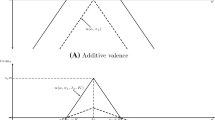Abstract
The theoretical literature on two candidate elections is dominated by symmetric contests and vote-maximizing candidates. These models fail to capture two important features of real elections. First, most elections pit a stronger candidate against a weaker one. Second, candidates care not only about holding office, but also about policy outcomes. Ignoring any one of these features means we will fail to capture an important dynamic—strong candidates must balance their desire to change policy with their need to win the election. We provide conditions for the existence of an equilibrium in the spatial model with non-policy factors, when candidates are policy motivated. We provide a characterization of ‘regular’ equilibria and show that there exists at most one regular equilibrium. We provide conditions that guarantee that all equilibria are regular. We derive comparative statics for the model and show that increasing a candidate’s non-policy advantage causes that candidate to move towards his ideal point.
Similar content being viewed by others
References
Adams J, Merrill S III (2003) Voter turnout and candidate strategies in American elections. J Polit 65: 161–189
Adams J, Merrill S III, Grofman B (2005) A unified theory of party competition. Cambridge University Press, New York
Alvarez MR, Nagler J (1995) Economics, issues, and the Perot candidacy: voter choice in the 1992 presidential election. Am Polit Sci Rev 3: 714–744
Ansolabehere S, Snyder JM Jr (2000) Valence politics and equilibrium in spatial election models. Public Choice 103: 327–336
Ansolabehere S, Snyder JM Jr, Stewart C III (2001) Candidate positioning in U.S. House elections. Am J Polit Sci 45: 136–159
Aragones E, Palfrey TR (2002) Mixed equilibrium in the Downsian model with a favored candidate. J Econ Theory 103: 131–161
Banks J, Duggan J (2005) Probabilistic voting in the spatial model of elections: the theory of office motivated candidates. In: Social choice and strategic decisions: essays in honor of Jeffrey S. Banks, David Austen-Smith, John Duggan (eds) Springer, New York
Callander S, Wilson CH (2006) Context-dependent voting. Q J Polit Sci 1: 227–254
Calvert R (1985) Robustness of the multidimensional voting model: candidate motivations, uncertainty, and convergence. Am J Polit Sci 29: 69–95
Coughlin PJ, Nitzan S (1981) Electoral outcomes with probabilistic voting and nash social welfare optima. J Public Econ 15: 113–122
Danskin JM (1966) The theory of max–min, with applications. SIAM J Appl Math 4: 641–664
Debreu G (1952) Existence of a social equilibrium. Proc Natl Acad Sci 38: 886–893
Downs A (1957) An economic theory of democracy. Harper and Row, New York
Duggan J (2005) A survey of equilibrium analysis in spatial models of elections. Working paper
Duggan J (2006) Endogenous voting agendas. Soc Choice Welf 27: 495–530
Duggan J, Fey M (2005) Electoral competition with policy-motivated candidates. Games Econ Behav 51: 490–522
Enelow JM, Hinich MJ (1982) Non-spatial candidate characteristics and electoral competition. J Polit 1: 115–130
Erikson RS, Romero DW (1990) Candidate equilibrium and the behavioral model of the vote. Am Polit Sci Rev 84: 1103–1126
Erikson RS, Wright GC, McIver JP (1994) Statehouse democracy: public opinion and the American States. Cambridge University Press, Cambridge
Fan K (1952) Fixed-point and minimax theorems in locally convex linear spaces. Proc Natl Acad Sci 38: 121–126
Fiorina M (1973) Electoral margins, constituency influence, and policy moderation: a critical assessment. Am Polit Q 1: 479–498
Glicksberg IL (1952) A further generalization of the Kakutani fixed point theorem, with applications to nash equilibrium. Proc Natl Acad Sci 38: 170–174
Groseclose TJ (2001) A model of candidate location when one candidate has a valence advantage. Am J Polit Sci 45: 862–886
Groseclose TJ (2007) ‘One and a half dimensional’ preferences and majority rule. Soc Choice Welf 28: 321–335
Hinich MJ (1977) Equilibrium in spatial voting: the median voter result is an artifact. J Econ Theory 16: 208–219
Lacy D, Burden BC (1999) The vote-stealing and turnout effects of Ross Perot in the 1992 presidential election. Am J Polit Sci 43: 233–255
Lin TM, Enelow JM, Dorussen H (1999) Equilibrium in multi-candidate probabilistic voting. Public Choice 98: 59–82
Martin AD, Quinn KM, Whitford AB (1999) Voter choice in multi-party democracies: a test of competing theories and models. Am J Polit Sci 43: 1231–1247
Mas-Colell A (1985) The theory of general economic equilibrium: a differentiable approach. Cambridge University Press, Cambridge
McKelvey R (1976) Intransitivities in multidimensional voting models and some implications for agenda control. J Econ Theory 12: 472–482
McKelvey R, Patty JW (2006) A theory of voting in large elections. Games Econ Behav 57: 155–180
Meirowitz A (2007) Electoral contests, incumbency advantages, and campaign finance. Working paper
Milgrom P, Segal I (2002) Envelope theorems for arbitrary choice sets. Econometrica 2: 583–601
Peress M (2006) Securing the base: electoral competition under variable turnout. Working paper
Plott CR (1967) A notion of equilibrium and its possibility under majority rule. Am Econ Rev 57: 787–806
Powell L (1982) Issue representation in Congress. J Polit 44: 658–678
Roemer J (2001) Political competition: theory and applications. Harvard University Press, Cambridge
Schofield N (1978) Instability of simple dynamic games. Rev Econ Stud 45: 575–594
Schofield N (2003) Valence competition in the spatial stochastic model. J Theor Polit 15: 371–383
Schofield N (2004) Equilibrium in the spatial ‘valence’ model of politics. J Theor Polit 16: 447–481
Schofield N, Martin AD, Quinn KM, Whitford AB (1998) Multiparty electoral competition in the Netherlands and Germany: a model based on multinomial probit. Public Choice 97: 257–293
Simon LK, Zame WR (1990) Discontinuous games with endogenous sharing rules. Econometrica 58: 861–872
Stokes DE (1963) Spatial models of party competition. Am Polit Sci Rev 57: 368–377
Wittman D (1983) Candidate motivation: a synthesis of alternatives. Am Polit Sci Rev 77: 142–157
Wittman D (2005) A valence model of elections and the median-crossing property: a diagrammatic exposition. Public Choice 124: 365–382
Author information
Authors and Affiliations
Corresponding author
Rights and permissions
About this article
Cite this article
Peress, M. The spatial model with non-policy factors: a theory of policy-motivated candidates. Soc Choice Welf 34, 265–294 (2010). https://doi.org/10.1007/s00355-009-0396-2
Received:
Accepted:
Published:
Issue Date:
DOI: https://doi.org/10.1007/s00355-009-0396-2




